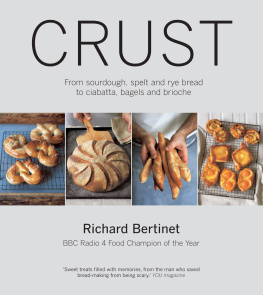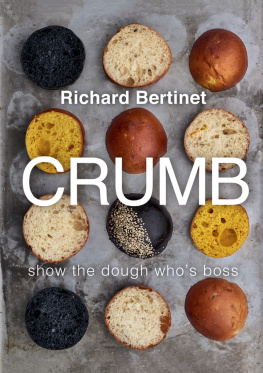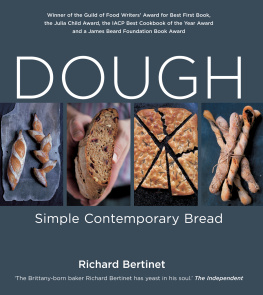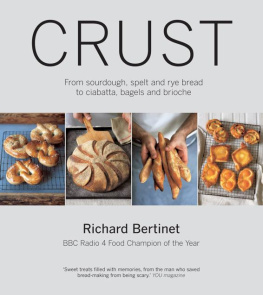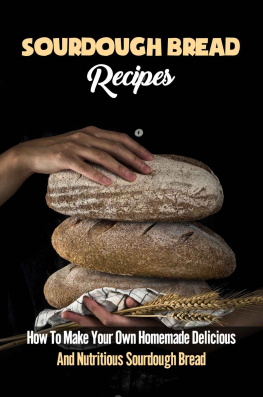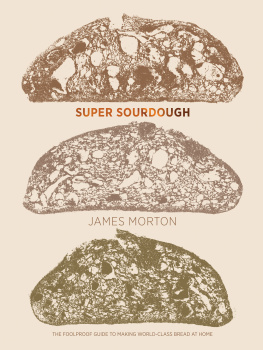Contents
Guide



For Lola Maude with all my love
Acknowledgements
Once again I owe a huge debt of gratitude to Sheila Keating for her advice, impeccable judgement and for doing with my thoughts what I can do with flour and water. To Kyle Cathie for supporting my ideas and letting me get on with it. To Jean Cazals for more beautiful pictures, to Jenny Semple for her fabulous design and ideas, to Sophie Allen for keeping the train on the tracks and to all of the team at Kyle Cathie who have a part in getting my scribbles to the book shelf. To Zed Ondrousek for his invaluable assistance with all of the baking and to Janice Teitzel (our Roo) for being a rock when we needed one you are always welcome back.
To Elodie Stanley for her advice and input on nutrition; to Bloomsbury Store, Cath Kidston and the Bath Antiques Centre for the loan of their beautiful china, napery and knick-knacks; and to Tim White and John Warwick for all their work on the DVDs.
To our many loyal customers at The Bertinet Kitchen, and especially those who have come to do our bread classes, often from a great distance, all of whom have helped us identify the issues that they and others face when baking at home and to the Barson and Page families for being my taste test panel.
Finally, to Aude Lebesgue for her support at home while we worked on the book and to Jo and the children, Jack, Tom and Lola Maude, who make it all worthwhile.
Richard
NOTE: All the preparation timings for recipes are approximate and will depend on how long it takes you to work your dough. Preparation timings do not include ferment timings as you may have made your ferment before you start the recipe. Please ensure you read the recipes thoroughly before you begin.

CONTENTS
HOW TO USE THIS EBOOK
Select one of the chapters from the and you will be taken to a list of all the recipes covered in that chapter.
Alternatively, jump to the to browse recipes by ingredient.
Look out for linked text (which is in blue) throughout the ebook that you can select to help you navigate between related recipes.
You can double tap images to increase their size. To return to the original view, just tap the cross in the top left-hand corner of the screen.
INTRODUCTION
When I wrote my first book, Dough, my dream was simply to get everyone hooked on making bread. I wanted to keep everything as straightforward as possible, so that people who never believed they could bake would realise what fun and satisfaction there is from making their own bread. And the feedback I have received has been extraordinary. It makes me very happy when people tell me that something they once thought was too complicated and confusing has become second nature. This email from someone who also came to one of my classes just says it all for me this is why I love teaching people how to make bread:

.This morning I rose early, baked solo for the first time and the entire family sat down together for breakfast with warm bread. It was a fantastic sight! Last night I cleared our freezer of 19 loaves of supermarket bread. I feel so proud.
Getting a taste for baking is a great start, but now I want to show you how to apply the straightforward approach of making simple breads to slightly more complex doughs. Sourdough and croissants, especially, are the things everyone wants to learn how to make. So this book, together with the dvd, is for those of you who are baking happily, but want to take the journey a little further, to explore some breads that require you to take things more slowly, try a few new techniques, or use different flours from chestnut to buckwheat, or the unusual red Cabernet grape flour I have discovered.
Ive called this book Crust because, if youll forgive the pun, it includes the kind of breads that you can really get your teeth into. Also, a fantastic crust is one of the most significant things about great bread be it a sourdough loaf or a baguette. A brilliant crust forces you to really chew your bread, and when you chew you produce saliva, which contains the enzymes that break down carbohydrates and get your digestion going properly.

It doesnt matter where you are, what conditions youre working in, there is always a way to work a little magic with flour and water.
By comparison soft, pappy (and, now, sometimes completely crustless), highly processed, additive-filled commercial bread needs little chewing and often isnt digested properly, leaving people feeling bloated, and sometimes convinced they have an allergy to wheat but more on this later, in Chapter 5.
When you have been baking all your life, working with dough becomes second nature. It goes beyond technique. You get to understand and empathise with the way the dough may behave slightly differently, depending on the temperature in the kitchen or whether it is a stormy or humid day, and instinctively you adjust. Remember we are talking about something organic that changes and develops and reacts. If I find myself baking in an unfamiliar kitchen for example, when I do demonstrations, where the atmosphere, let alone the oven, will inevitably be different I find myself adding a little more water, a little less yeast, reducing the proving time. When you bake every day, its as if your brain engages with the ingredients, the ambient conditions, and with the dough you are going to make, even before your hand goes into the bag of flour. It doesnt matter where you are, what conditions youre working in, there is always a way to work a little magic with flour and water.

You never stop discovering different techniques or unusual ingredients that bring a whole new dimension to your breadmaking.
All of this is incredibly important when you are working in a bakery, because your customers expect bread of a consistent standard, every single day. In my native France, if your bread is beautiful one day, but less so the next, customers will just go to another bakery. At home, of course, such degrees of perfection are less important than the fact that you are making something good and wholesome for yourself and your family. And if you follow the recipes and techniques in this book, you will bake very good, tasty bread, regardless of the quirks of your kitchen, or the vagaries of the weather. But you will also notice that on some days the dough behaves slightly differently, or your bread turns out to be better than usual.

